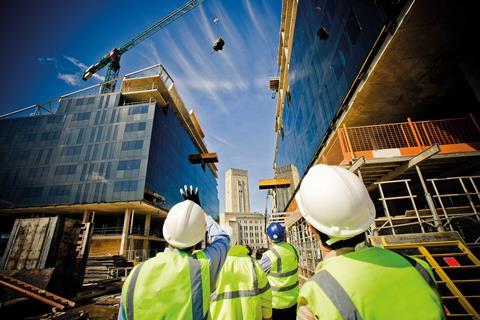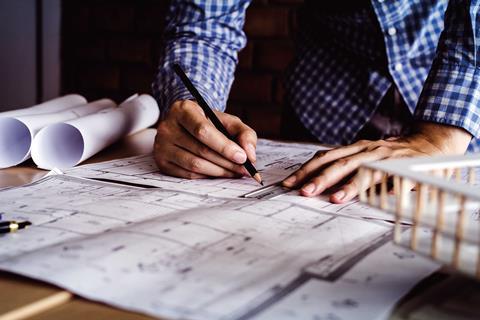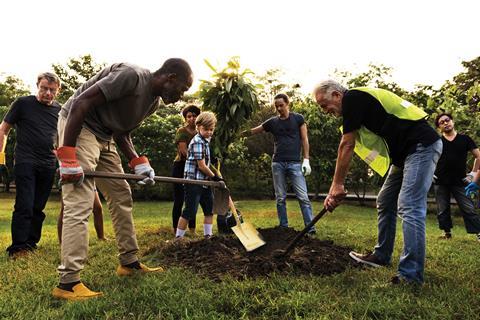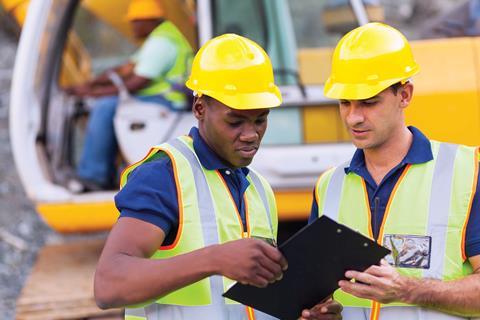Social value is now a crucial factor in construction firms winning work, but a growing band of professionals want to do more to improve people’s lives. This week, Building is launching an initiative to shine a spotlight on projects that aim to do good.
To kick off, Jamie Harris talks to experts about the origins of social value – and where it could be going next.


“This is not just about building a great building and doing some nice ‘fluffy’ stuff on the side for our communities,” says Su Pickerill, group community investment manager at Wates. Pickerill is paid to care about the long-term impact of buildings on people’s lives. She is part of a growing band of professional do‑gooders with phrases such as “social value” and “community engagement” in their job titles – a decade ago these jobs were rare in construction, now they are the norm.
Providing social value is now crucial on public sector contracts
Pickerill started off in the charity sector before switching a decade ago to the construction industry with a focus on sustainability. These days, she leads a team that supports Wates’ public sector bids by demonstrating the social value the company can create – through benefits such as local job creation or apprenticeship places – and she finds social enterprise partners to make sure the promises are delivered on.
Providing social value is now crucial on public sector contracts, with everyone on a project – from architects and contractors to consultants and subcontractors – playing a part in trying to deliver it.

Increasingly at Building, we hear how important it is for you to find ways to create better environments for communities, and so this week we are launching an editorial initiative called ”delivering social value”. This is a chance to explore your hopes and aspirations in this area, to report on innovative ways of working and to visit inspiring projects with proven outcomes. We want to know how the social value agenda has affected your career or your company’s performance, and we want to uncover the challenges and barriers that can prevent construction making a real difference to society.
And we start by speaking to social value specialists about the origins of the social value movement, progress made so far and how the definition of doing good may change and adapt in the future.
Back to its roots
Social value is not a new concept. It was not even a fresh concept when the 2012 Social Value Act was passed, which requires public sector bodies to consider societal, economic and environmental benefits for their area during the procurement process. Prior to 2012, legislation such as the Equality Act (2010), the Disability Discrimination Act (1995) and the international Millennium Development Goals (2000) all steered the sector towards creating a fairer, more sustainable and more accessible built environment.
People started talking about “public value” in the 1990s, says Chris Brown, executive chair and founder of Igloo Regeneration. “There was an understanding that there were things other than financial outcomes that were important, particularly in public policy – that’s how social value really took off.”
The emphasis for construction firms shifts towards delivering societal benefits
This month, the government announced that it is changing the way it directs its capital investment. This will no longer be based on gross value added – how much economic benefit a project promises – but will focus on improving the wellbeing of the local community or reducing regional productivity gaps.
One consequence of this decision will be the redirection of funding to other areas, mostly in the Midlands and the north of England, that Westminster has deemed “left behind”. This change could pave the way for social value to become an even bigger factor in winning public sector work – worth £27bn last year – as the emphasis for construction firms shifts towards delivering societal benefits.

Still, despite a more favourable backdrop, delivering social value remains challenging. In 2015, the government published a review of its Social Value Act after just 15% of English councils said that they had applied it to their procurement processes. It highlighted three main barriers: a lack of awareness of the act, varying understanding of how to apply it, and the lack of standardised ways in which to measure social value. So, what progress is being made?
Shifting focus
Contractors’ awareness is certainly greater now than it ever has been – principally because the bottom line is no longer the sole factor that will win public sector work. Peter Masonbrook, associate director at Faithful + Gould, says: “Social value is no longer a ‘nice to have’ – if you do not adopt and deliver it, you will lose work.”
Firms tendering for public sector contracts are increasingly finding that councils allocate 10% of pre-qualification questionnaire marks – in some cases as much as 30% of the overall bid – to social value.
Most of the biggest contractors include social value in their annual reports
Bidding for public sector work requires a real understanding of how to deliver social value, which has led to a recruitment drive for new skills. Many firms employ social value leads, or a team of social value specialists who work with the business developing bids for work or working with those on site to ensure the social value that won the work is realised.
Most of the biggest contractors include social value in their annual reports. Mace’s latest report has three separate mentions of the phrase; Balfour Beatty prints the phrase eight times and Kier on 13 occasions. Mace says it has created £491m in value to society (an increase from the previous year’s figure of £449m). Kier says it generated £310m of social value, up from £157m.
Impressive as these figures are – and as benchmarks for how much companies are contributing, they are certainly helpful – Igloo’s Brown warns that the industry as a whole needs to be sure it understands the financial sums it attaches to social value activity because at the moment “there is a degree of arbitrariness to how the monetary values are set”.
There is also an argument that not everything should have numbers attached to it, particularly if firms want to push the boundaries of what can be achieved. For example, Wates recently created a community vegetable garden, and while this is not easy to put a figure on, no one doubts it will be beneficial for residents’ mental and physical health. As Pickerill says: “You cannot get the essence of the difference you have made to a person’s life onto a spreadsheet.”
Philip Watson, Director HLM Architects

There is increasing consideration being given to the “social value” of infrastructure and development. The issue is now de rigueur, a new lexicon is manifesting alongside the appearance of social value awards categories and social value champion appointments across the construction industry. The increased awareness and interest in social value very welcome, after all, it is the social impact of architecture that drives our practice.
What we should be saying is, “Good design adds value – economically, socially and ecologically.”
Since 2012, local authorities have awarded contracts based on value for money rather than initial capital costs and many developers and contractors have reacted in kind with their own measures of social value to help them secure this work. However, almost all this is focused on the construction phase of development, with little emphasis on the operational impacts and virtually no consideration of the role design can have in generating social value. “Good design doesn’t cost money,” is a mantra that many designers repeat but this only recognises part of the picture. What we should be saying is, “Good design adds value – economically, socially and ecologically.”
The big challenge facing architects and designers is how to demonstrate this value in objective and tangible ways. As an industry, we have a poor track record in doing post-occupancy evaluation of any kind, and even if we do, how can we capture the impact of good design on communities? How can we measure the advantages? There is no common or accepted methodology. But we can seize the initiative to demonstrate the value of our profession.
The RIBA is developing a social value toolkit, due to be published by the RIBA Practice Committee sometime soon. We hope it will enable us to demonstrate improved design outcomes. What is desperately needed is a consistent measure of social value that is recognised by policy makers to become a yardstick for future investment.
Intangibles
The good news is that many firms and individuals are looking beyond the requirements of pre-qualification questionnaires or company reports – there is a real move to avoid box-ticking and instead hunt for more sophisticated social value measures.
Dr Sarah Fitton is a social value specialist who set up a consultancy after completing a PhD researching the social value of infrastructure. “We give businesses advice on how they deal with their social value from a company or a project perspective. People need to get to grips with everything from identifying it, creating it, articulating it, reporting on it, and then selling the story as well,” she says.
It’s about identity and inclusion, health and wellbeing, creating natural capital in green spaces in what we design and build as a sector.
Vicky Hutchinson, Atkins
Social value is evolving into something that has a lasting legacy on communities, with architects and planners putting an emphasis on how their designs will positively affect mental health and wellbeing. A recent celebrated example is Mikhail Riches’ Goldsmith Street housing scheme, winner of the 2019 RIBA Stirling prize, and lauded for the social benefits of its design.
“It is not just about employment and skills any more,” explains Vicky Hutchinson, environment practice director for infrastructure at Atkins. “It’s about identity and inclusion, health and wellbeing, creating natural capital in green spaces in what we design and build as a sector.”

The problem, however, with trying to achieve so much more through social value is that as the definition widens it can become much harder to pin down. Some would argue social value has always been vague because the legislation does not include a definitive list of benefits. But now that some companies are going beyond quantitative measures – such as counting the number of apprenticeships or volunteer hours totted up – and starting to take on the longer-lasting impact a design might have on community wellbeing, it becomes more difficult to measure.
Standardisation and tools
These challenges are compounded by a lack of standardisation in the language used – and what firms are being asked for – leading some to simply ignore that part of the pre-qualification questionnaire or to not understand what is required of them.
Equally, clients may be demanding something they cannot adequately define. Fitton thinks woolly descriptions from clients have clouded the issue. It varies from one client to another, too. Some public bodies prescribe specific outcomes they want from a project, while others ask bidding firms to come to the table with ideas. Others require a set proportion of spending to be on social value measures, leaving how that is spent up to the business.
Fitton says: “I call it the dark arts of social value. It is very dependent on the client, on the project – it’s even dependent on the stakeholders that you’re working with.”
The RIBA is expected to launch its social value toolkit for architects this year

New tools for measuring social value have been launched to help clarify this. The Social Value Portal launched its national TOMs framework in 2017. Standing for themes, outcomes and measures, it lists more than 50 ways social value can be embedded and aims to provide a minimum reporting standard for each.
Housing body HACT published a toolkit for contractors and housing providers in 2016 and has set up a social value “bank” of methodology to make a basic assessment of social impact. Social Value UK launched its social profit calculator, a software platform designed to quantify the value of the seemingly intangible. And there are more to come. The RIBA is expected to launch its social value toolkit for architects this year.
Storytelling
Social value is still a work in progress – some in construction have embraced it and are forging ahead while others are suspected of just going through the motions to release the next tender or submit the next bid. John Dunne, a director at Wates, says: “There are certain public sector bodies at the forefront, but I would say there is still a very long tail of laggards who are not clued up on why they are doing what they are doing, and for what long-term purpose.”
What will turn the dial so that everyone values social value? Wates’ Pickerill thinks the answer is not in reeling off multimillion-pound figures but in telling a compelling narrative about the communities at the heart of the project. She says: “I really like the idea of storytelling – we need to be hearing the stories of the lives the decisions will affect. It’s exciting to have that level of influence.”
These are the stories we want you to tell us about. Construction has the chance to push the boundaries of what can be achieved under the banner of social value, and through Building’s coverage this year, we intend to shine a light on the impact your work is having on society.



























No comments yet